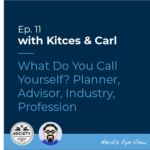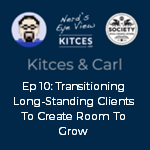
When clients are panicking and on the verge of making emotionally-driven (and potentially irrational decisions), there's an opportunity for advisors to use empathy to build trust and strengthen the relationships to be able to talk clients off the ledge. Recent insights from behavioral finance show us ways to genuinely relate to clients by understanding their fears on an objective and intellectual level. But once an advisor makes an empathetic connection, how does the advisor then move that conversation forward to help their client actually make a more rational decision?
In our 18th episode of Kitces & Carl, Michael Kitces and financial advisor communication expert Carl Richards extend their last podcast and look at communication strategies advisors can use to set the stage for helping clients actually make better decisions after ‘talking them off the ledge’, using a three-part pyramid framework: the Plan, at the foundation of the pyramid (representing the financial plan itself that was developed around the client’s personal values and goals); the Process, in the middle (i.e., the method whereby an advisor helps their client determine how those values and goals will become reality); and the Product, at the top of the pyramid (which are the tools that were chosen but that are now the focus of the client’s fears and anxieties).
By using such an approach, an advisor can draw the client’s attention away from the initial cause of alarm – that place in the ‘branches’ of irrational ideas driven by emotional turmoil – back to the grounding ‘roots’ of the client’s financial plan, which (as they’ll be reminded) was built around their own personal values and unique goals. And then, once the client is (hopefully) back at a place where their point of reference is centered on their foundational values and goals (instead of on whatever external, uncontrollable news story or event that made them worry in the first place), it’s at that point where data and evidence can (finally) be brought into the discussion and how the plan originally factored in the potential for both good and bad outcomes to begin with!
Because changing the perspective back to the fundamentals of what they’re trying to accomplish can have a huge impact on a client’s behavior; without that context (and especially under the influence of sensationalized market news), the reasoning behind the product can be easily forgotten and difficult to understand, making that product seem arbitrary and potentially senseless in a turbulent environment. By contrast, with the (reminded) context of the plan, staying within the parameters of the client’s plan will almost always now seem the best course of action for them to weather whatever turmoil the market might be experiencing at any given moment.
Ultimately, the key point is that, by establishing trust through a connection built on empathy, we as advisors can help upset clients remember how the foundation of their plan, based on their personal values, was used to develop the unique portfolio and recommendations designed to bring their financial goals to fruition. And by re-centering the client’s focus back to their original plan, an advisor can make all the difference in helping a client maintain the grit they’ll need to stay on course regardless of whatever transient turbulence the client may perceive.











